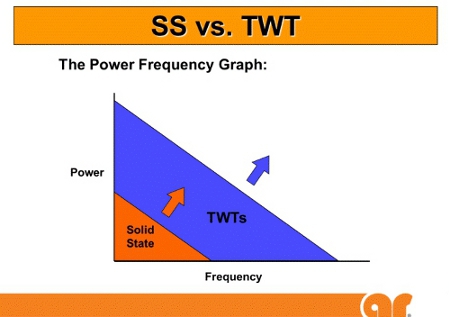GaN The TWT Killer? Not So Fast


By Paul Kruczkowski, Editor
Gallium nitride’s (GaN) meteoric rise to darling of the RF design industry has been accompanied by some lofty predictions. One such claim is that the emergence of GaN solid-state semiconductors means certain death for traveling wave tube (TWT) technology. As it turns out, GaN might not replace TWTs after all, at least not for the foreseeable future. Although GaN has captured market share from TWTs in some lower-power, lower-frequency applications, there is much evidence suggesting TWT technology is alive and well.
I recently spoke with Asif Anwar, director of the Strategic Technologies Practice at Strategy Analytics, about this trend. He told me that his discussions with TWT industry experts at the 2012 IEEE MTT-S International Microwave Symposium (IMS2012) and the Farnborough International Air Show 2012 point to renewed optimism in the TWT market. “TWTs are seeing a mild resurgence, or at least a cessation in the perceived move toward solid-state technologies for radar, EW (electronic warfare), and communication systems,” he explained.
Subsequent conversations with TWT technology suppliers substantiated Anwar’s claim. Tony Challis, product manager for TWTs and subsystems at e2v, told me that both sales and new opportunities for helix TWTs are at an all-time high for military applications, and that initial interest in e2v’s microwave power modules (MPMs) has already converted to two significant program wins and an increasing pipeline of TWT opportunities. Steven Olson, market manager for dB Control, said that, despite pressures from GaN, demand for TWT amplifier (TWTA) products remains strong, and his company is currently working on the largest TWTA contract in its history. “Solid-state is absolutely a threat and has encroached upon lower frequency requirements, but as GaN continues to creep into TWT’s domain, we work with TWT manufacturers to push the boundaries of bandwidth and frequency,” he added.
To date, GaN’s greatest impact on the TWT market has been below 6 GHz, and lower-power applications up to 18 GHz are likely to see pressure from GaN technology soon. Funding for defense programs that incorporate GaN devices, such as advanced Active Electronically Scanned Array (AESA) radar and Next Generation Jammer (NGJ) technology, will also advance GaN technology. “The introduction of new higher-power GaN devices every year will advance GaN solid-state technology on the power frequency graph [see below],” said Joe Diesso, VP of marketing at AR RF/Microwave Instrumentation, itself a supplier of TWT amplifiers.

Without the significant research dollars that GaN solid-state technology receives, TWT technology development will be much more evolutionary in nature; however, it is not a stationary target waiting to be replaced by GaN. Improvements in tube technology have led to higher reliability and longer tube life (100,000 hours in some cases). The move to multiple collector tubes has increased TWT efficiencies — bandwidths are now approaching three octaves, and research and development to increase output power and frequency continues.
In order to be the TWT killer it was expected to be, GaN it will have to show it can beat TWT at its own game, which is extremely high power and efficiency. The limited power density of a single GaN device and its heat dissipation will be limiting factors in achievable power. In addition, losses and inefficiency associated with power combining multiple GaN devices will make it difficult to achieve power level above 10 kW in the short term. Tube technology has been pronounced dead many times over the years — the emergence of GaN is just the latest reason — but as in the past, this prognostication has proven to be premature.
